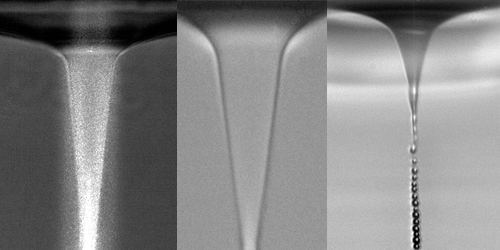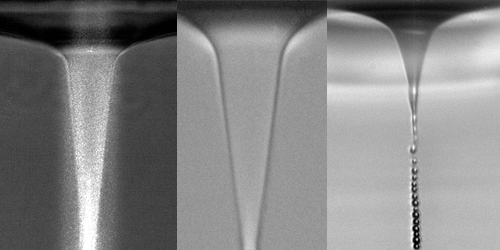Light Shapes Flat Liquid Interfaces into Cones
A liquid drop subjected to a high voltage will deform into a cone that can spew a tiny jet of liquid from its tip. Now Antoine Girot and colleagues at the University of Bordeaux, France, demonstrate that radiation pressure from a laser beam can also shape a liquid interface into a cone. The team says that their technique provides a route to optically deform liquid interfaces and create a “spray” of drops, which might be useful for dispensing micrometer-sized volumes of liquid.
In their experiment, the group focused a laser beam on the soft interface between salty water and toluene—two immiscible liquids. The photons in the laser exerted a pressure on the system as they bounced off the interface. For a laser power of about 1 W and above, the team observed that the resulting radiation pressure was sufficient to deform the liquid-liquid interface into a conical shape. They also observed that these liquid cones can emit liquid “jets” from their tips.
To describe the deformation, Girot and colleagues derived a model that accounts for the radiation pressure, the surface tension of the interface, and the buoyant force against the deformation. As the interface bends, becoming more inclined, the model predicts a sudden drop in the laser’s ability to further deform the interface, a behavior that contributes to setting the cone angle. The researchers calculate that the cone angle depends on the laser’s power and beam size as well as on the liquids’ properties, such as their refractive indices. They found good agreement with their experimental data for water and toluene, as well as seven other immiscible fluid pairs.
This research is published in Physical Review Letters.
–Nicolas Doiron-Leyraud
Nicolas Doiron-Leyraud is a Corresponding Editor for Physics based in Montreal, Canada.





